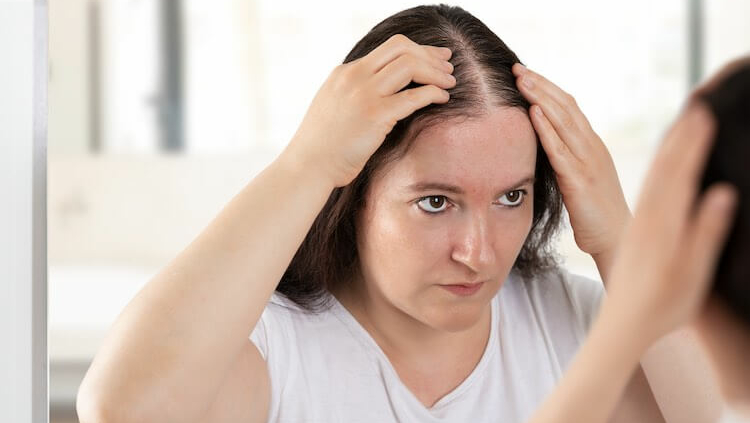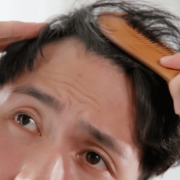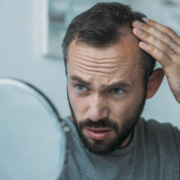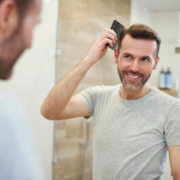Normal vs. Excessive Hair Loss: Here’s How to Tell the Difference

“Nooooo! Don’t let her use my bathroom. She gets hair everywhere!” screams my son every time my daughter asks to use his tub. Yes, it’s true. She has long, thick hair and leaves a trail. That’s always been the case, and shedding is the norm for his sister. Is that the case for everyone? How do you know whether the daily amount of hair you lose is normal? After all, determining whether the number of strands you see in the sink is okay can be tricky. You don’t want to be paranoid, but you also don’t want to gloss over the situation if your hair really does need some extra attention. When it comes to normal vs. excessive hair loss: here’s how to tell the difference.
You Naturally Lose a Certain Amount of Hair Each Day
Your hair goes through a growth cycle that includes a stage when hair rests and then sheds. That’s a fancy way of saying that it falls out. So, losing a certain amount of hair each day is normal. Here’s how your hair’s growth cycle works, along with the approximate timing of each stage:
Growth phase (3-5 years)
About 90 percent of the hair on your head is in a growth phase at any given time. During this stage, hairs push out of the follicles and continue to grow until they’re cut, or they reach the end of their lifespan.
Transition phase (10 days)
The transition phase comes just after the growth phase. Only a small amount, about five percent, of your hair is in the transition phase at any given time. This is when your hair follicles shrink, and growth slows down a bit. Hair doesn’t shed quite yet.
Resting phase (3 months)
Next comes the resting phase, which affects about 10 to 15 percent of your hair. Your hair doesn’t grow during this phase but doesn’t shed either. That’s why it’s called a resting phase.
Shedding phase (2-5 months)
Some scientists believe there are three phases of the hair growth cycle rather than four. The reason is that it can be difficult to distinguish between the two stages. People can lose anywhere from 50 to 100 hairs per day when their hair sheds. Yes, that seems like a lot of hair, but it’s completely normal.
There are Times When You Lose More Hair Than Normal, And That’s Okay
Losing hair for any reason is enough to send you to the mirror searching for thinning areas or bald spots. There are some perfectly rational reasons why you could lose more hair than normal, though. On those occasions, you’ll have to try not to panic. Your hair will grow back. When your body goes through any trauma, the hair growth cycle can get disrupted, triggering the resting stage earlier than expected. The disruption can occur if you’ve had COVID-19, the flu, or any other illnesses. Surgery, stress, weight loss, pregnancy, and other events that temporarily shock your body can have the same effect. Not to worry, though. Normal growth patterns will return on their own over time. Stress is one of the primary contributors to hair loss, so try your best to reduce your stress levels when you can.
Other Times, You’re Losing Too Much Hair
So here’s the big money question. When are you losing too much hair? Let’s start with this. So far, the discussion we’ve been having is about shedding. When your hair sheds, it usually grows back on its own without any intervention. Hair loss is a different story. Hair won’t grow back on its own without intervention or hair growth treatment.

If you’ve racked your brain and there hasn’t been anything unusual that could have disrupted your hair’s growth cycle, it’s time to schedule an appointment with your dermatologist. There are many causes for hair loss, and they can help you determine why you may be losing excessive hair. Some common reasons why include the following:
1. Genetic hair loss
If Mom, Dad, Grandpa, Aunt Betty, or any other blood relative on either side of your family has a history of thinning or balding hair, you may have inherited their hairline. Androgenetic alopecia, a.k.a male or female pattern baldness, is the most common form of hair loss among men and women who have gone through puberty. If this is the case for you, don’t worry. A lot of progress has been made in researching, identifying, and developing effective regrowth treatments. The most effective oral and topical treatments, including Minoxidil, Finasteride, Dutasteride, Spironolactone (our women’s formula), and other DHT blockers, are available by prescription. Lower doses of topical Minoxidil are available over-the-counter.
2. Autoimmune hair loss
Many different types of autoimmune diseases can lead to hair loss. Some people may be more predisposed to autoimmune hair loss if they have other autoimmune conditions such as Hashimoto’s thyroid disease or Lupus. There are many types of autoimmune hair loss. One is alopecia areata which manifests as small, circular bald spots on various parts of your scalp. It’s a tricky condition because it’s unpredictable. Hair sometimes spontaneously grows back. Other times, the condition goes into a long remission and reappears years later. There’s also lichen planopilaris and other types of scarring alopecia that behave exactly like their names. Little scars grow over your hair follicles, cause your hair to fall out, and block new hair from emerging.
Autoimmune hair loss is rare. Yes, we’ve been hearing more about it since celebs started sharing their stories. But, that doesn’t mean that you have it. Let your dermatologist diagnose you rather than using WebMD.
3. Environmental hair loss
All the hair loss we’ve discussed so far stems from inside your body. Environmental conditions can cause direct damage to the outside of your hair, making it break or fall out. Let’s start with hair styling. Bleach, color treatments, perms, and other chemicals may give you immediate gratification, but over time, they can cause structural damage to your hair. When the outer cuticle gets lifted, the bonds inside your hair weaken and break. Dreadlocks, tight braids, and ponytail holders can cause traction alopecia resulting in temporary or permanent hair loss. Trichotillomania, compulsive hair pulling, can also cause hair loss. If you manage the factors contributing to the damage early enough, your hair can grow back. Deep conditioners, regular trims, and, in some cases, Minoxidil will help.
Here’s What to Do if You Think Your Hair Loss is Excessive
It never hurts to get a professional opinion if you’re stressed out about the hairballs you’re finding on the shower floor. Don’t worry. Your dermatologist won’t think you’re an alarmist. They’ve seen it all. If you are losing hair, an early diagnosis and immediate treatment will minimize hair loss and get you on the road to regrowth faster.
Don’t want to wait for an appointment? Let Happy Head help, all of our services are done online and without appointment. Fill out a short questionnaire about your hair loss, and one of our board-certified dermatologists will determine whether you will benefit from prescription-grade hair regrowth formula. You can also skip the pharmacy and have your prescription delivered directly to your front door in discreet packaging.









